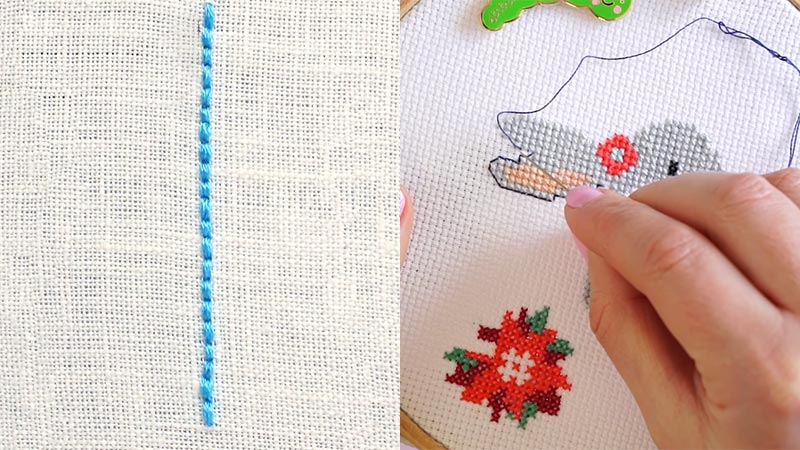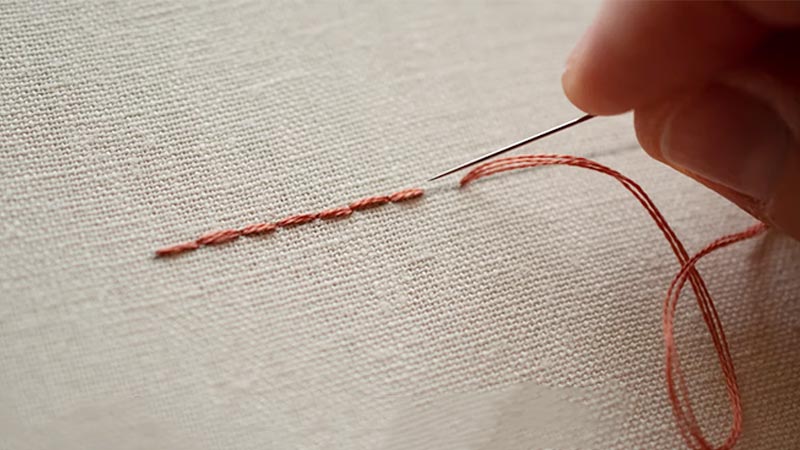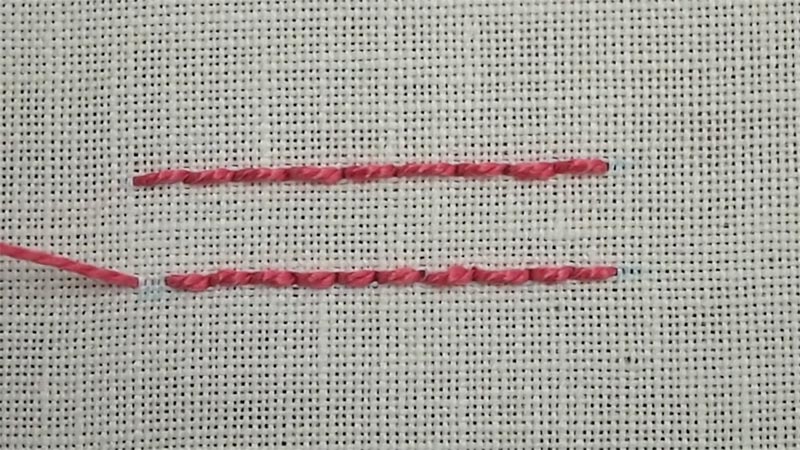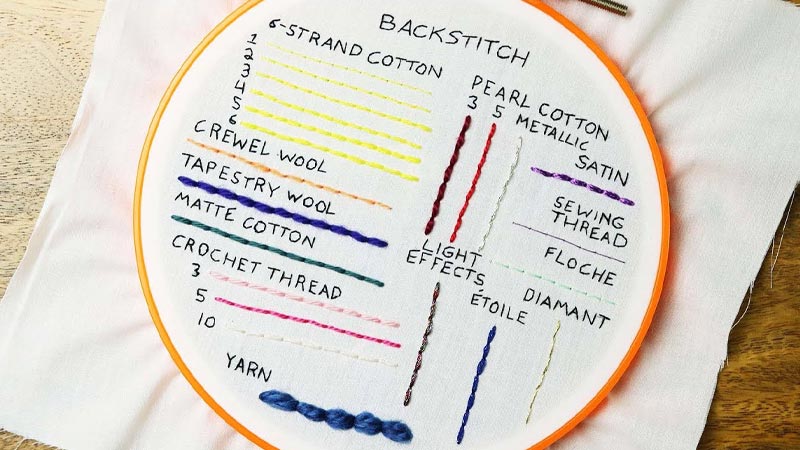“Backstitching” is a fundamental technique in sewing and embroidery that plays a pivotal role in reinforcing seams, adding precision, and enhancing the durability of fabric projects. It involves sewing backward over a previous stitch, securing the thread, and preventing unraveling.
This versatile method not only fortifies seams but also creates well-defined outlines, making it invaluable in the world of embroidery. Backstitching provides a pathway to intricate detailing, adding a professional and polished appearance to the final product.
In this exploration of backstitching, we will delve into its significance, the various applications, and the step-by-step process of mastering this technique, whether you’re a seasoned crafter or a novice in the world of fabric arts.

What Is Back Stitching?
Backstitching is a sewing technique used to reinforce seams, create outlines, or add details in sewing and embroidery. It involves sewing backward over a previous stitch, anchoring the thread, and preventing it from unraveling.
To backstitch, one begins with a single forward stitch, then moves the needle backward, creating a new stitch that overlaps the last one. This process continues, forming a continuous line or shape.
Backstitching provides added strength and durability, making it particularly useful in high-stress areas of clothing seams. In embroidery, it offers clarity, definition, and precision, enhancing the appearance of designs by creating clean, well-defined lines and shapes.
Why Is Back Stitching Important in Fabric Arts?
Backstitching, a fundamental technique in fabric arts, holds a distinct importance that goes beyond its basic applications.
Here’s a fresh perspective on why backstitching is crucial in the world of fabric arts:
Structural Integrity
Backstitching serves as the backbone of many fabric projects, reinforcing seams and anchoring threads. It imparts strength and stability to the work, preventing unraveling and ensuring that the piece endures the test of time.
Seam Durability
In garment construction, where fabrics undergo frequent stress and movement, backstitching reinforces seams, particularly in high-stress areas such as hems and closures. This added strength prevents the fabric from tearing or fraying, prolonging the life of clothing items.
Fine Detailing
Backstitching allows for intricate detailing in embroidery. It is the go-to method for creating crisp, well-defined lines, outlining shapes, and adding precision to designs. This precision is invaluable in translating intricate artistic visions onto fabric.
Professional Finish
The polished and professional appearance that backstitching imparts to fabric projects cannot be overstated. Whether it’s in clothing, home decor, or embroidery, this technique elevates the quality of the final piece, making it more visually appealing and marketable.
Customization
Backstitching enables artists to add a personal touch to their work. Whether it’s embroidering a name, date, or special message, this technique allows for creative customization, making each piece unique and meaningful.
Heritage and Tradition
Backstitching is deeply ingrained in the heritage of fabric arts. It connects contemporary crafters to the rich history of textile traditions, honoring the craftsmanship of the past and preserving cultural legacies.
Versatility
Beyond its functional role, backstitching is a versatile tool for artistic expression. It can be creatively adapted to add decorative elements, create patterns, and infuse artistry into fabric projects.
Therapeutic Value
Engaging in backstitching can be a therapeutic experience. The rhythmic and repetitive nature of the technique can be calming, offering a meditative escape from the stresses of daily life.
What Is Back Stitch Used For?

Backstitch is a fundamental sewing and embroidery technique used for a variety of purposes due to its versatility and strength.
Here are some of the primary applications of the backstitch:
Seam Reinforcement
Backstitching is commonly used to reinforce seams in sewing. It secures the initial and final stitches in a seam, preventing it from unraveling over time.
This is crucial in garments and other fabric items to ensure the longevity and durability of the stitched seams, especially in high-stress areas.
Outline and Detailing in Embroidery
Backstitch is a cornerstone technique in embroidery for outlining shapes, adding fine details, and defining patterns. It creates crisp and clean lines, which enhance the overall appearance of the design, providing structure and clarity to the embroidery work.
Preventing Fraying
In both sewing and embroidery, backstitching helps secure the threads, preventing them from fraying or coming loose over time. This is especially important for maintaining the integrity of the fabric and the design, ensuring that your work remains intact and looking its best.
Decorative Elements
Backstitching is not only functional but can also be decorative. It’s used to create decorative patterns, lines, or lettering on fabric, adding an aesthetic dimension to various textile projects.
Patchwork and Appliqué
When attaching patches, appliqués, or additional pieces of fabric to a base material, backstitching helps anchor them securely. This ensures that the added elements remain firmly in place, even when the fabric is subject to regular use.
Button Attachment
When sewing buttons onto garments or accessories, backstitching is essential to secure them in place. It ensures that the buttons remain firmly attached, preventing them from coming loose or falling off.
Mending and Repairs
Backstitching is often used for mending and repairing fabric tears, holes, or damaged seams. It provides a durable and long-lasting solution, extending the life of clothing and other fabric items.
Decorative Edging
In quilting, backstitching can be used to create decorative edging or to secure binding to the edges of a quilt, adding both functionality and a finishing touch to the project.
How to Back Stitch Embroidery?

Backstitching in embroidery is a technique used to outline shapes, add definition, and create crisp, clean lines in your design.
Here’s how to backstitch in embroidery:
Gather Your Materials
Before you begin, gather all the materials you’ll need for your embroidery project. This includes your embroidery fabric, embroidery hoop (if desired), embroidery floss in your chosen color, embroidery needle, and a pair of scissors.
Set Up Your Fabric
If you’re using an embroidery hoop, place your fabric in it and tighten the hoop to ensure the fabric is taut. This will make it easier to work on and produce more consistent stitches.
Thread Your Needle
Cut a length of embroidery floss (usually about 18-24 inches) and separate it into the number of strands you want to use for your project. Thread your embroidery needle with the floss and tie a knot at the end of the thread, leaving a short tail.
Start with a Single Stitch
Bring your needle up from the backside of the fabric to the front at the starting point of your embroidery line. This initial stitch will serve as your reference point for the backstitch.
Create the First Backstitch
Insert the needle back into the fabric a short distance ahead in the direction you want to sew. Then, bring the needle back up through the fabric at the starting point of your first stitch. This creates the first backward stitch, securing the initial stitch in place.
Continue Backstitching
To continue backstitching, insert the needle forward again, slightly ahead of the last stitch, and then bring it back up at the end of the previous stitch to create the next backward stitch.
Each backward stitch should overlap with the previous forward stitch, forming a continuous line. Maintain even tension in your stitches for a clean, consistent appearance.
Repeat the Pattern
Continue repeating the process of inserting the needle forward, creating a forward stitch, and then bringing the needle back up to form a backward stitch. Continue this pattern along the desired outline or shape in your design.
The size of your stitches will determine the level of detail and definition in your embroidery.
Complete the Backstitch
Carry on with the backstitch until you reach the end of the line or shape you are outlining. To finish, insert the needle into the fabric and secure the thread with a knot on the backside. Make sure the knot is tight and trim any excess thread.
What Are the Different Types of Backstitches?

Backstitches are a group of sewing techniques that involve sewing backward over a previous stitch to secure threads and reinforce seams. While the standard backstitch is the most common, there are variations that serve different purposes.
Here are some different types of backstitches:
Standard Backstitch
This is the foundational backstitch, where a backward stitch is sewn over the previous forward stitch. It is versatile and used for reinforcing seams, creating outlines, and adding durability to fabric projects.
Half Backstitch
In a half backstitch, the backward stitch is shorter than the forward stitch, resulting in a staggered or dashed line effect. It is often employed in embroidery to achieve different visual effects or for fine detailing.
Double Backstitch
This variation involves sewing two backward stitches over each previous forward stitch. It creates an even stronger and more robust seam. Double backstitch is utilized in heavy-duty sewing projects or where extra reinforcement is needed.
Decorative Backstitch
Beyond functionality, backstitching can be used decoratively by varying stitch length and spacing. By adjusting the length and gap between stitches, intricate patterns, ornate lines, or even text can be created, adding an artistic element to sewing and embroidery projects.
Whipstitch
Although not a true backstitch, the whipstitch is sometimes referred to as a backstitch variation because it involves sewing backward in a whip-like motion. It is commonly used for securing the edge of a fabric piece to another fabric, providing a simple and strong seam.
Ladder Stitch (Invisible Stitch)
Ladder stitch is not a traditional backstitch, but it entails sewing backward to create an almost invisible seam. It is used to close openings in sewing projects, such as pillow covers or stuffed animals, leaving no visible stitches on the outside.
FAQs
Can backstitching be used in both hand-sewn and machine-sewn projects?
Yes, backstitching can be used in both hand-sewn and machine-sewn fabric projects. While it’s more commonly associated with hand sewing and embroidery, it’s also applicable in machine sewing, particularly when reinforcing seams or adding fine details.
What’s the best thread to use for backstitching in fabric arts?
The choice of thread for backstitching depends on the project. For hand-sewn projects and embroidery, embroidery floss or a quality sewing thread is often used. In machine sewing, a strong, matching thread is recommended for backstitching.
How does backstitching compare to other sewing and embroidery techniques in terms of durability?
Backstitching is one of the most durable techniques in sewing and embroidery. It excels in reinforcing seams and preventing thread fraying, making it ideal for high-stress areas. However, its durability is matched by techniques like lockstitching and satin stitching, which are used for specific purposes.
Is backstitching reversible if you make a mistake?
Backstitching is generally not reversible, especially if done with strong and closely spaced stitches. To correct a mistake, it’s often necessary to remove the stitches carefully, which can be time-consuming. Taking care and practicing your technique can help avoid mistakes.
Can beginners learn backstitching in fabric arts, or is it a more advanced technique?
Backstitching is suitable for beginners and experienced fabric artists alike. It’s one of the foundational techniques taught to beginners due to its simplicity and versatility. With practice, beginners can quickly become proficient in backstitching.
To Recap
Backstitching stands as an indispensable cornerstone in the realms of sewing and embroidery. Its power lies in its dual nature, combining both functionality and artistry. By anchoring stitches in a backward motion, reinforces seams, prevents fraying, and imparts strength to fabric projects.
Beyond these practical attributes, it is a vehicle for precision and detailing, elevating the visual appeal of designs with well-defined outlines and intricate patterns.
Whether employed for durability in the construction of garments or to add artistic flair to decorative embroidery, backstitching has remained a timeless and essential technique.
Its versatility and enduring relevance make it an invaluable skill, a bridge between tradition and contemporary creativity in the ever-evolving world of fabric arts.
Leave a Reply